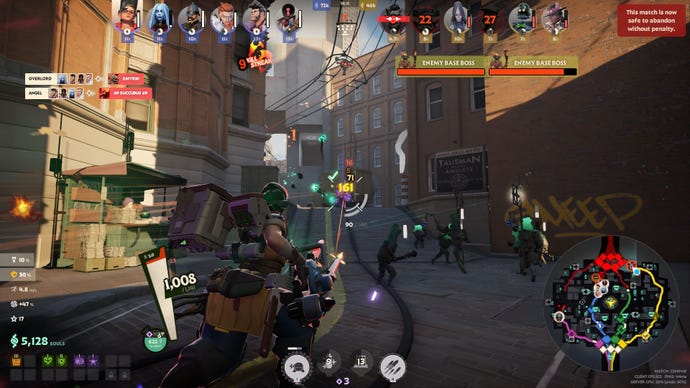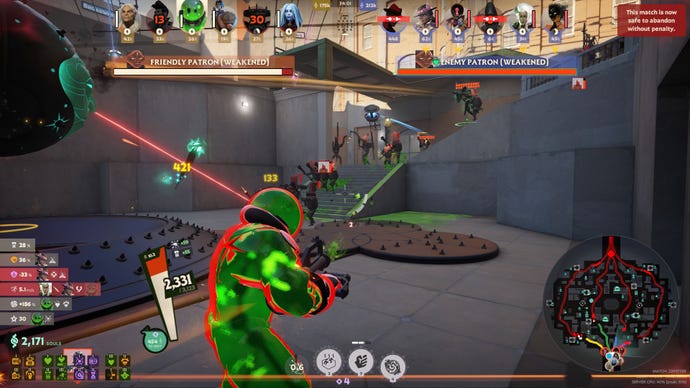Deadlock gives me the shakes. Valve’s not-so-secret third-person MOBA shooter is a fiercely competitive game of push and pull through monster-peppered city streets. You’ll get into hectic scrapes with a giant blob man and come out of it sweating and swearing, and possibly alive. It is tactical, deep, instinctive, and an interesting work-in-progress. It elicits adrenaline almost as much as it forces murder economics down your piehole. This is the kind of game that puts you into a blistering, exciting (and confusing) battle for survival, then displays a graph when you lose. I need to get as far away from it as possible.
I’ve only played around 8 hours, an impoverished investment when you consider this is the de facto follow-up to Dota 2, a heavy-hitting PC bruiser that can fluidly funnel away thousands of player hours like some terrifying Los Angeles storm drain for personal time. This isn’t a review though, it’s just some quick impressions based on what’s available in Valve’s ongoing “I know a guy who knows a guy” form of viral playtesting. I won’t get swept away.
If you’ve graced the ooze-stained halls of a multiplayer online battle arena in the past, you’ll recognise the setup. Each team push their way down four “lanes”, killing weak enemy minions and slurping up their souls as cash. Along the way, you encounter large golem-like guardians that act as strategic blockades (the towers of other MOBAs). Kill them to earn yet more souls and handy spell slots, then push on toward the enemy base. Once you’ve arrived, there are some more obstacles to shoot, and a big orbulent and vulnerable “patron” to destroy, which will win you the game. The enemy, meanwhile, is trying to do the same thing in the opposite direction.
There’s lots more to it, obviously. This incarnation has fun ziplines to get you back into the action quickly after a death. You can doublejump and dash and slide around. At any moment, you might feel the need to stop pushing a lane and go farm cycloptic gremlins for souls, or pick up a special urn and carry it across the map, or team up and take on a neutral boss in the middle of the arena.
These shifting goals make matches feel more like a battlefield of waxing and waning tactical manoeuvres, at the expense of the tidiness and relative simplicity that comes in other competitive multiplayer games like Overwatch. Its strength lies in complexity, and in the pressure and adrenaline of exciting team fights. To someone who prefers focus and fears percentages, this can make it challenging to get into. Deadlock is a game for violent and quick-witted hummingbirds, and I’m a dumb pigeon.
The complexity is mostly the result of a shop where you upgrade your character as the battle rages. This offers an overwhelming selection of buffing bits and bolstering bobs. There are items that turn bullets into lifestealing biters, others that reduce all negative status effects, others that decrease cooldown times, or boost your stamina so you can double jump more often. Some higher cost items allow you to become briefly invincible, or slow every enemy around you, or summon a magic carpet for a quick escape.
I’m wording these more succinctly than the game, which splashes a card full of numbers and information into your eyes like the worst optometrist. No item simply does one thing. “Slowing bullets” will slow any enemy you hit, for example, but also grant +16% weapon damage and 5 spirit power (whatever that is – I’m still not sure). A “combat barrier” will give you a shield against bullets but also increase your fire rate and weapon damage while that shield is up. I’m picking the easiest examples, because I have to make sure you keep reading. But there are many items much more intricate in their stat-altering. It’s more or less required that you study and learn the item shop while outside of a game (that’s why Valve put it right there on the main menu for you).
As someone who prefers their rock paper scissoring more streamlined, this library of buffs can feel like an overcomplication of what is, at its core, a straightforward objective: go kill the big monster at the end of the road. But this is a MOBA, after all. The point is to allow for many potential combinations of hero “build”. That menu screen I find so uninviting will be catnip to minmaxers, DPS chasers, and myriad Dota 2 veterans.
Even those versed in the genre might make it difficult to decipher the facts of the battlefield, though. Who is hitting who, and with what? Never mind the matrix of potential hero builds, there is more flashy VFX occurring during a battle than a lapsed Overwatcher can reasonably track. This is basically where endless nights of Deadlock sessions will come into play, practice gradually filling gaps in your understanding and reflexes. Like Dota 2 or many other competitive games, Deadlock is shaping up to be a game you must not just learn to play, but also learn to read.
It sounds like a chore, yet is also meant to be this way. Valve’s longtime game design ethos has been to lean into the messiness of criss-crossing percentages and the attention-fluttering multi-tasking of their most financially successful multiplayer game. But tinkering with an economy of health talismans and bullet trinkets has always been less interesting to me than the other major method of designing for fun ‘n’ games – ie. to actually change the nature of play by giving somebody a big stretchy boot, or a wand that turns concrete walls into a cloud of butterflies, or whatever. Deadlock does follow both approaches. It’s a hero-filled MOBA after all – the abilities of each bulletbastard is what makes the game work. Those abilities need to be distinct and interesting, though. And I’ve struggled to find characters that really interest me.
For many matches I went with the bullet-hosing minigunner McGinnis, because she has some handy turrets that do a bit of shooting for you. I’d equip her with items that granted her an even bulkier magazine and she would eventually shoot toxic bullets at an increasingly powerful rate. As the match continues you unlock “flex” slots, which let you pile even more buffing items into your bulging minmax monstrosity. Here, I liked to slide a “Leech” ability, which made my bullets slurp the life out of any enemy struck by them.
Likewise, I enjoyed the roly-poly nuisance behaviour of Viscous – a green goo guy who can transblobbify into a rolling ball of gunge, reminiscent of violent hamster Wrecking Ball in Overwatch. The vampiric beeflord Abrams was also good fun, in the sense that just being near him is undesirable, because he might at any moment start sapping the life of all within a fifteen foot radius. The high level fun will come in how good teams bandy their abilities together. I felt smug about any blockading wall I summoned that stopped an enemy escaping from the bullet horror of another character, Wraith, who periodically unleashes a very Reaper-like dance of death.
And yet, due to the nature of the game’s item-grubbing and upgrade-chasing, the pure utility of hero abilities can feel obscured. Every death, every misjudged charge into a fateful fray will bring questions. Did death come swift because that samurai has a bunch of items stacking DPS? Or because he did some ability I missed? What is allowing this hero to silence your powers – is it one of their innate abilities, or an item? How has the enemy team farmed that many souls already?
There are answers to these questions in the damage reports that pop up when you bite the dust, in the post-match summary, and that dreaded graph of failure. But, again, it requires a considerable investment (and probably lots of YouTube tutorials) to fully grasp the ins and outs of exactly what you’re doing wrong. That may give the game a type of sports-like longevity, but it is the kind of dopamine-delivering hamster wheel of victory-chasing I am a little afraid to embrace right now.
I can’t deny the fierceness of Deadlock’s hectic play. Many final stands and perilous pushes into contested turf reliably squeezed all the alert juice from my adrenal-gland, leaving me with the recognisable post-game heartbeat of a close Overwatch map or a tough Tekken fight. This is the feeling all murderously competitive games seek to bring forth. It makes it easy to view the unfinished Deadlock as already being a success, a sure thing, destined to be played endlessly by millions (also: it’s a Valve game with lots of hype around it).
But that prophecy is not set in stone. On top of the fact that “games as a service” can easily lose their appeal (and audience) in a relatively short time, there’s also nothing truly revolutionary about Deadlock in its core design. Strip it back to the fundamentals, and it remains Dota 2 in third person. All the interesting bits and bobs come in its subtleties – elegant to the MOBA elite, and harder to notice for anyone else. From a business perspective (ugh) Valve are essentially competing against their own most popular game.
So if, like me, you see a lot of friends dipping into Deadlock, and you’re getting that familiar curdling feeling of FOMO in your belly, you need only ask yourself:
- Do I have a thousand hours to spare?
- Have I bounced off Dota 2 or Smite or Overwatch in the past?
Deadlock is more approachable than Dota 2, that much is true. But what game isn’t? There’s not much in its essential design so far to suggest it really wants to meet the MOBA-skeptical halfway. If anything, it leans into that field of ever-increasing complexity, throwing new globs of goo at the wall to see what sticks. Me? It’s intoxicating goo. I’m desperately washing it off.
Credit : Source Post






